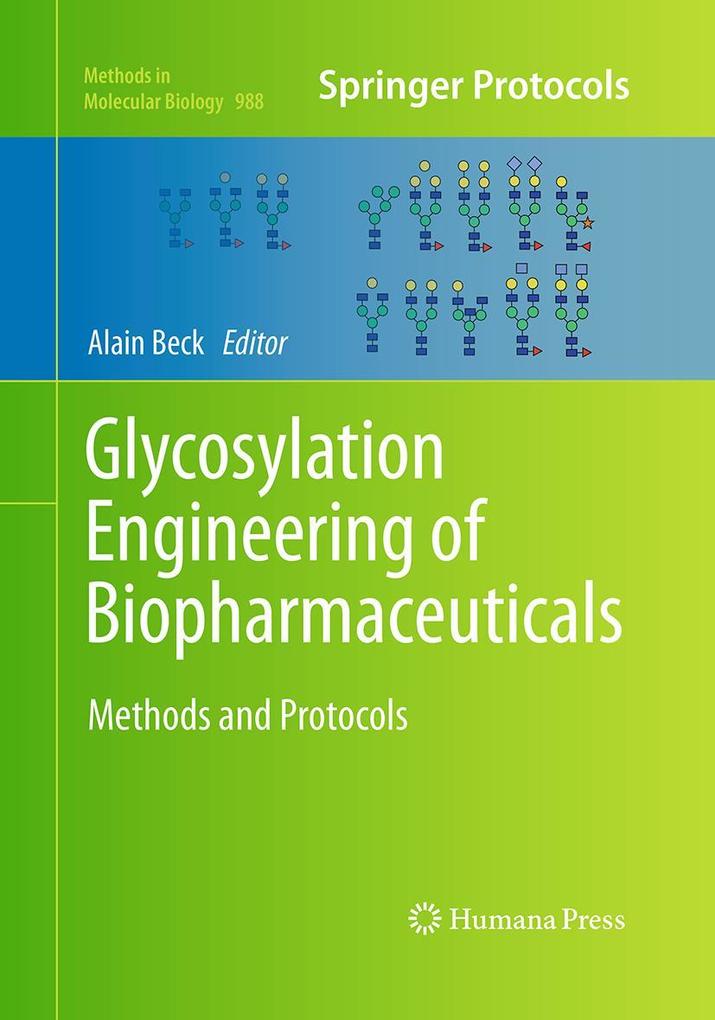
Zustellung: Mo, 26.05. - Mi, 28.05.
Versand in 2 Tagen
VersandkostenfreiBestellen & in Filiale abholen:
This Methods in Molecular Biology(TM) book offers protocols for glycoproteins and glyco-engineered biopharmaceuticals with a focus on mAbs. Covers glyco-engineering of therapeutic proteins, glycoanalytics, glycoprotein complex characterization and PK/PD assays.
Glyco-engineering is being developed as a method to control the composition of carbohydrates and to enhance the pharmacological properties of monoclonal antibodies (mAbs) and other proteins. In Glycosylation Engineering of Biopharmaceuticals: Methods and Protocols, experts in the field provide readers with production and characterization protocols of glycoproteins and glyco-engineered biopharmaceuticals with a focus on mAbs. The volume is divided in four complementary parts dealing with glyco-engineering of therapeutic proteins, glycoanalytics, glycoprotein complexes characterization, and PK/PD assays for therapeutic antibodies. Written in the highly successful Methods in Molecular Biology(TM) series format, chapters include introductions to their respective topics, lists of the necessary materials and reagents, step-by-step, readily reproducible laboratory protocols, and tips on troubleshooting and avoiding known pitfalls.
Authoritative and cutting-edge, Glycosylation Engineering of Biopharmaceuticals: Methods and Protocols serves as an ideal guide for scientists striving to push forward the exciting field of engineered biopharmaceuticals.
Inhaltsverzeichnis
Engineering of Therapeutic and Diagnostic O-Glycans on Recombinant Mucin-Type Immunoglobulin Fusion Proteins Expressed in CHO Cells. - Engineering a Human-Like Glycosylation to Produce Therapeutic Glycoproteins Based on 6-Linked Sialylation in CHO Cells. - Glycoengineered Pichia-Based Expression of Monoclonal Antibodies. - N-Glycosylation Humanization for Production of Therapeutic Recombinant Glycoproteins in Saccharomyces cerevisiae. - Engineering the Baculovirus Genome to Produce Galactosylated Antibodies in Lepidopteran Cells. - Nano LC Chips MS/MS for the Characterization of N-Glycopeptides Generated from Trypsin Digestion of a Monoclonal Antibody. - Cetuximab Fab and Fc N-Glycan Fast Characterization Using IdeS Digestion and Liquid Chromatography Coupled to Electrospray Ionization Mass Spectrometry. - Therapeutic Antibody Glycosylation Analysis: A Contract Research Organization Perspective in the Frame of Batch Release or Comparability Support. - Mass Spectrometric Analysis of O-Linked Oligosaccharides from Various Recombinant Expression Systems. - Assessing Fc Glycan Heterogeneity of Therapeutic Recombinant Monoclonal Antibodies Using NP-HPLC. - Application of Capillary Electrophoresis in Glycoprotein Analysis. - Characterization of Glycoprotein Biopharmaceutical Products by Caliper LC90 CE-SDS Gel Technology. - Hydrophobic Interaction Chromatography to Analyze Glycoproteins. - Lectin Glycoprofiling of Recombinant Therapeutic Interleukin-7. - Analysis of Monoclonal Antibodies by Sedimentation Velocity Analytical Ultracentrifugation. - Noncovalent Mass Spectrometry for the Characterization of Antibody/Antigen Complexes. - Conformational Analysis of Recombinant Monoclonal Antibodies with Hydrogen/Deuterium Exchange Mass Spectrometry. - Epitope Mapping of Antibodies by Mass Spectroscopy: A Case Study. - Evaluation of Antibody-Dependent Cell Cytotoxicity Using Lactate Deshydrogenase (LDH) Measurement. - Evaluation of Complement Dependent Cytotoxicity Using ATP Measurement and C1q / C4b Binding. - Capture of the Human IgG1 Antibodies by Protein A for the Kinetic Study of h-IgG / FcgR Interaction Using SPR-Based Biosensor Technology. - Mass Spectrometry Protocol for the Absolute Quantification of a Monoclonal Antibody in Serum with Immunopurification.
Produktdetails
Erscheinungsdatum
23. August 2016
Sprache
englisch
Auflage
Softcover reprint of the original 1st edition 2013
Seitenanzahl
372
Reihe
Methods in Molecular Biology
Herausgegeben von
Alain Beck
Verlag/Hersteller
Produktart
kartoniert
Abbildungen
XV, 355 p.
Gewicht
699 g
Größe (L/B/H)
254/178/21 mm
Sonstiges
Previously published in hardcover
ISBN
9781493962662
Entdecken Sie mehr
Pressestimmen
From the reviews:
The book is intended as a reference manual of protocols and best practices for the practicing bench scientist. The authors do a marvelous job of covering a wide variety of tools and techniques and bringing them together in one volume. This collection of protocols will find an audience with experimentalists in the biopharmaceutical industry as well as various academic labs. Overall, I would strongly recommend this book . (Bibhash Mukhopadhyay, Frontiers in Pharmacology, September, 2013)
This book useful as it details in one place the current state of art technologies and techniques for antibodies. I enjoyed reading the introductions to each chapter, which were accessible and gave an historical setting and overall aim for the methodologies that are set out in the chapter. this book offers a good reference guide for those of us working in this area. (Sian Estdale, BTS Newsletter The British Toxicology Society, Issue 43, Winter, 2013)Bewertungen
0 Bewertungen
Es wurden noch keine Bewertungen abgegeben. Schreiben Sie die erste Bewertung zu "Glycosylation Engineering of Biopharmaceuticals" und helfen Sie damit anderen bei der Kaufentscheidung.










